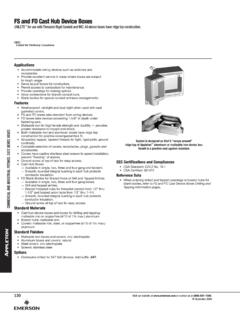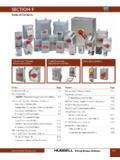Transcription of CHAPTER-6 governing system - IIT Roorkee
1 147 CHAPTER-6 HYDRO-TURBINE governing system (Reviewed by Dr. R. Thapar) Introduction governing system or governor is the main controller of the hydraulic turbine. The governor varies the water flow through the turbine to control its speed or power output. Generating units speed and system frequency may be adjusted by the governor. governing system as per IEEE std. -75 includes following. a) Speed sensing elements b) Governor control actuators c) Hydraulic pressure supply system d) Turbine control servomotors-these are normally supplied as part of turbine TO (SPEED SIGNALGENERATOR)TURBINEFLOWCONTROLW ICKETGATES ORNEEDLEHYDRAULICAMPLIFIERSERVOMOTORPILO TSERVOMOTOROR HYDRAULICTRANSDUCERCONTROLSPEEDSENSINGSP EED(FREQUENCY)SIGNAL FROM PT(SHP ONLY)GOVERNORLEVEL,OTHERSUPERVISORYCONTR OLSET POINTS ADJUSTMNETS(DROOP;JOINT CONTROL)TECHOMETERSPEEDSW ITCHESFEED BACK Figure : governing system Block Diagram (Typical) The primary functions of the hydraulic turbine governor are as follows: i) To start, maintain and adjust unit speed for synchronizing with the running units/grid.
2 Ii) To maintain system frequency after synchronization by adjusting turbine output to load changes. iii) To share load changes with the other units in a planned manner in response to system frequency error. iv) To adjust output of the unit in response to operator or other supervisory commands. v) To perform normal shut down or emergency over speed shut down for protection. In isolated systems the governor controls frequency. In large system it may be needed for load operation control for the system . A block diagram is shown in figure Digital electronic load governor are now employed. Mechanical analogue electronic governors used in earlier plants are also briefly discussed. In small hydro units digital governors are employed for plant control and protection also which is discussed in detail in Vol.
3 II - Control and Protection. 148 Basic Control system Governor control system for Hydro Turbines is basically a feed back control system which senses the speed and power of the generating unit or the water level of the forebay of the hydroelectric installation etc. and takes control action for operating the discharge/load controlling devices in accordance with the deviation of actual set point from the reference point. Governor control system of all units controls the speed and power output of the hydroelectric turbine. Water level controlled power output controllers can be used for grid connected units. governing system comprises of following sections (figure ). a) Control section b) Mechanical hydraulic Actuation section Figure Basic Governor Control system (Typical) The control section may be mechanical; analogue electronic or digital electronic.
4 Actuator can be hydraulic controlled, mechanical (motor) or load actuator. Load actuator are used in micro hydro range; mechanical (motor operated) actuators may be used say up to about 1000 kW unit size. Hydraulic actuators are mostly used. Actuator system compares the desired turbine actuator position command with the actual actuator position. In most of the hydroelectric units reaction turbines are used. In these turbines it requires positioning of wicket gates, including turbine blades in Kaplan units. In Pelton units it requires positioning of spear and deflector. Pressure oil system with oil servomotor is most commonly used actuator. In micro hydros electronic loads controllers are used and shunt load bank is adjusted.
5 Governor Capacity (oil servomotor) Governor capacity rating in meter-kilogram is the capacity of the wicket gates/nozzles and blade servo motors (Kaplan units) as required for operation of the turbine at minimum rated oil pressure. USBR Engineering monograph no. 20 criteria is mostly followed. The size, type, and cost of governors vary with their capacity to perform work which is measured in (meter-kilograms). Governor having a capacity of more than 8500 m kg are of cabinet actuator type. Those having a capacity less than 7000 m kg are gate shaft type. The capacity is the product of the following factors: turbine gates servomotor area, governor minimum rated oil pressure, and turbine gates servomotor stroke.
6 For gate shaft governors, the turbine gates servomotor area is the net area obtained by subtracting the piston rod area from the gross piston area. For governors controlling two servomotors mounted directly on the turbine, the effective area is the sum of the net area of the two servomotors. Servomotor capacity can be estimated by following empirical relations: 1. Wicket gates servomotor capacity. FYM = 34 (hwh ) (metric) Set pointUnit SpeedOptional Feedbacks GovernorControllerTurbineControlActuator To Turbine ControlDevice (Gates,Blades, Needles,Deflectors, Load)\HydraulicPressure OilMechanical MotorLoadSpeed Power WaterLevel 149 Where, FYM = Servomotor capacity (m. kg.) M = wicket gate height hwh = maximum head, including water hammer, and Dg = wicket gate circle diameter 2.
7 Blade servomotor capacity (adjustable blade Kaplan turbine). - The blade servomotor capacity also varies among manufacturers. This can be roughly estimated by the formula: FYb = ()()2/1max4 metrics Where FYb = Servomotor capacity (m. kg.) Hmax = maximum head, ns = design specific speed, in metric HP units Pmax = turbine full-gate capacity at Hmax. Governor Capacity electronic Load Controller (shunt load governors) These controllers recommended for hydro generating units in micro hydro range should have dump load capacity equal to the generator rating. Type of Governor Controller Mechanical Controller Early mechanical governors were directly driven by prime movers through belt for small machines.
8 The speed of rotation was sensed by fly-ball type pendulum. In second-generation mechanical governors, permanent magnet generator and pendulum motor were utilized for sensing the speed of the machine. The isodrome settings were achieved through mechanical dashpot and droop setting by link mechanism. These mechanical governors were fully capable of controlling the speed and output of the generating unit in stable manner. In case of faulty pendulum, manual control of the units was possible with handles and knobs. This was PI type controller. Bhakra Left Bank commissioned in 1960-61 have mechanical cabinet governors supplied by M/s Hitachi Ltd. Cabinet type governors have remotely mounted servomotor and are referred as cabinet actuators.
9 Following operating control are on the cabinet face. i) Gate limit control ii) Speed level control iii) Speed droop control iv) Manual gate control v) Speed level indicator vi) Speed droop indicator vii) Speed indicators viii) Low speed switch ix) Oil pressure switch Electro-Hydraulic Governor Analogue Electronics Next came the third generation Electro-Hydraulic Governors where speed sensing, speed/output setting and stabilizing parameters were controlled electrically and the use of mechanical components was reduced considerably. They increased the reliability, stability and life of the equipment and facilitated more 150 functional requirements. The design of electrical part of the governors kept changing based on the advancement in electronics and development work by individual manufacturers.
10 In this type of governor analogue circuitry is used to develop set point signal that is used to position the control actuators of hydroelectric units. An electro hydraulic interface is used to connect the electronic set point signal into a hydraulic oil flow from a hydraulic servo valve system which determines the position of the turbine control actuators. This is a PID controller. Examples of Analogue electronic type hydraulic governor are as follow and a typical block diagram is shown in figure i) Bhakra Right Bank (5 x 120 MW) ii) Pong Power Plant (6 x 165 MW) iii) Dehar Power Plant (6 x 165 MW) iv) Chibro Power Plant All these were with cabinet type actuators.






